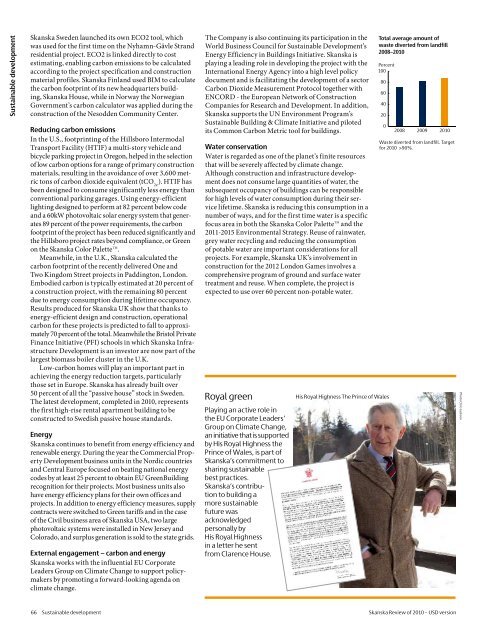Review of 2010 â USD version - Skanska
Review of 2010 â USD version - Skanska
Review of 2010 â USD version - Skanska
Create successful ePaper yourself
Turn your PDF publications into a flip-book with our unique Google optimized e-Paper software.
Sustainable development<br />
<strong>Skanska</strong> Sweden launched its own ECO2 tool, which<br />
was used for the first time on the Nyhamn-Gävle Strand<br />
residential project. ECO2 is linked directly to cost<br />
estimating, enabling carbon emissions to be calculated<br />
according to the project specification and construction<br />
material pr<strong>of</strong>iles. <strong>Skanska</strong> Finland used BIM to calculate<br />
the carbon footprint <strong>of</strong> its new headquarters building,<br />
<strong>Skanska</strong> House, while in Norway the Norwegian<br />
Government’s carbon calculator was applied during the<br />
construction <strong>of</strong> the Nesodden Community Center.<br />
Reducing carbon emissions<br />
In the U.S., footprinting <strong>of</strong> the Hillsboro Intermodal<br />
Transport Facility (HTIF) a multi-story vehicle and<br />
bicycle parking project in Oregon, helped in the selection<br />
<strong>of</strong> low carbon options for a range <strong>of</strong> primary construction<br />
materials, resulting in the avoidance <strong>of</strong> over 3,600 metric<br />
tons <strong>of</strong> carbon dioxide equivalent (tCO 2e<br />
). HTIF has<br />
been designed to consume significantly less energy than<br />
conventional parking garages. Using energy-efficient<br />
lighting designed to perform at 82 percent below code<br />
and a 60kW photovoltaic solar energy system that generates<br />
89 percent <strong>of</strong> the power requirements, the carbon<br />
footprint <strong>of</strong> the project has been reduced significantly and<br />
the Hillsboro project rates beyond compliance, or Green<br />
on the <strong>Skanska</strong> Color Palette TM .<br />
Meanwhile, in the U.K., <strong>Skanska</strong> calculated the<br />
carbon footprint <strong>of</strong> the recently delivered One and<br />
Two Kingdom Street projects in Paddington, London.<br />
Embodied carbon is typically estimated at 20 percent <strong>of</strong><br />
a construction project, with the remaining 80 percent<br />
due to energy consumption during lifetime occupancy.<br />
Results produced for <strong>Skanska</strong> UK show that thanks to<br />
energy-efficient design and construction, operational<br />
carbon for these projects is predicted to fall to approximately<br />
70 percent <strong>of</strong> the total. Meanwhile the Bristol Private<br />
Finance Initiative (PFI) schools in which <strong>Skanska</strong> Infrastructure<br />
Development is an investor are now part <strong>of</strong> the<br />
largest biomass boiler cluster in the U.K.<br />
Low-carbon homes will play an important part in<br />
achieving the energy reduction targets, particularly<br />
those set in Europe. <strong>Skanska</strong> has already built over<br />
50 percent <strong>of</strong> all the “passive house” stock in Sweden.<br />
The latest development, completed in <strong>2010</strong>, represents<br />
the first high-rise rental apartment building to be<br />
constructed to Swedish passive house standards.<br />
Energy<br />
<strong>Skanska</strong> continues to benefit from energy efficiency and<br />
renewable energy. During the year the Commercial Property<br />
Development business units in the Nordic countries<br />
and Central Europe focused on beating national energy<br />
codes by at least 25 percent to obtain EU GreenBuilding<br />
recognition for their projects. Most business units also<br />
have energy efficiency plans for their own <strong>of</strong>fices and<br />
projects. In addition to energy efficiency measures, supply<br />
contracts were switched to Green tariffs and in the case<br />
<strong>of</strong> the Civil business area <strong>of</strong> <strong>Skanska</strong> USA, two large<br />
photovoltaic systems were installed in New Jersey and<br />
Colorado, and surplus generation is sold to the state grids.<br />
External engagement − carbon and energy<br />
<strong>Skanska</strong> works with the influential EU Corporate<br />
Leaders Group on Climate Change to support policymakers<br />
by promoting a forward-looking agenda on<br />
climate change.<br />
The Company is also continuing its participation in the<br />
World Business Council for Sustainable Development’s<br />
Energy Efficiency in Buildings Initiative. <strong>Skanska</strong> is<br />
playing a leading role in developing the project with the<br />
International Energy Agency into a high level policy<br />
document and is facilitating the development <strong>of</strong> a sector<br />
Carbon Dioxide Measurement Protocol together with<br />
ENCORD - the European Network <strong>of</strong> Construction<br />
Companies for Research and Development. In addition,<br />
<strong>Skanska</strong> supports the UN Environment Program’s<br />
Sustainable Building & Climate Initiative and piloted<br />
its Common Carbon Metric tool for buildings.<br />
Water conservation<br />
Water is regarded as one <strong>of</strong> the planet’s finite resources<br />
that will be severely affected by climate change.<br />
Although construction and infrastructure development<br />
does not consume large quantities <strong>of</strong> water, the<br />
subsequent occupancy <strong>of</strong> buildings can be responsible<br />
for high levels <strong>of</strong> water consumption during their service<br />
lifetime. <strong>Skanska</strong> is reducing this consumption in a<br />
number <strong>of</strong> ways, and for the first time water is a specific<br />
focus area in both the <strong>Skanska</strong> Color Palette TM and the<br />
2011-2015 Environmental Strategy. Reuse <strong>of</strong> rainwater,<br />
grey water recycling and reducing the consumption<br />
<strong>of</strong> potable water are important considerations for all<br />
projects. For example, <strong>Skanska</strong> UK’s involvement in<br />
construction for the 2012 London Games involves a<br />
comprehensive program <strong>of</strong> ground and surface water<br />
treatment and reuse. When complete, the project is<br />
expected to use over 60 percent non-potable water.<br />
Royal green<br />
Playing an active role in<br />
the EU Corporate Leaders’<br />
Group on Climate Change,<br />
an initiative that is supported<br />
by His Royal Highness the<br />
Prince <strong>of</strong> Wales, is part <strong>of</strong><br />
<strong>Skanska</strong>’s commitment to<br />
sharing sustainable<br />
best practices.<br />
<strong>Skanska</strong>’s contribution<br />
to building a<br />
more sustainable<br />
future was<br />
acknowledged<br />
personally by<br />
His Royal Highness<br />
in a letter he sent<br />
from Clarence House.<br />
His Royal Highness The Prince <strong>of</strong> Wales<br />
Total average amount <strong>of</strong><br />
waste diverted from landfill<br />
2008–<strong>2010</strong><br />
Percent<br />
100<br />
80<br />
60<br />
40<br />
20<br />
0<br />
2008<br />
2009<br />
<strong>2010</strong><br />
Waste diverted from landfill. Target<br />
for <strong>2010</strong> >90%.<br />
Photo Chris Jackson<br />
66 Sustainable development <strong>Skanska</strong> <strong>Review</strong> <strong>of</strong> <strong>2010</strong> – <strong>USD</strong> <strong>version</strong>

















